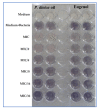Chemical Composition, Antibacterial and Anti-Quorum Sensing Activities of Pimenta dioica L. Essential Oil and Its Major Compound (Eugenol) against Foodborne Pathogenic Bacteria
- PMID: 35214872
- PMCID: PMC8876795
- DOI: 10.3390/plants11040540
Chemical Composition, Antibacterial and Anti-Quorum Sensing Activities of Pimenta dioica L. Essential Oil and Its Major Compound (Eugenol) against Foodborne Pathogenic Bacteria
Abstract
The Pimenta dioica essential oil and its main compound (eugenol) were tested for their antibacterial potency against eight Gram-negative and Gram-positive bacteria implicated in food intoxication. This essential oil and its main component were evaluated for their ability in inhibiting Quorum sensing (QS)-dependent mechanisms such as motility in Pseudomonas aeruginosa PAO1, production of violacein by Chromobacterium violaceum and biofilm formation on stainless steel and glass surfaces. Our results demonstrated that P. dioica essential oil and eugenol were active against all tested strains with a maximum of inhibition against Listeria monocytogenes CECT 933 (26.66 ± 0.57 mm). The minimal inhibitory concentration (MIC) value of the tested essential oil and eugenol was about 0.048 mg/mL for all strains. The obtained results demonstrated that 4CMI eugenol inhibited foodborne strains biofilm formation on the glass strips by 73.79% and by 75.90% on polystyrene. Moreover, 0.048 mg/mL (MIC) of P. dioica essential oil inhibited the violacein production by 69.30%. At 100 µg/mL, P. dioica oil and eugenol affected the motility of PAO1 by 42.00% and 29.17%, respectively. Low concentrations of P. dioica essential oil are active against the quorum sensing phenomena and biofilm potency. Thus, this essential oil could be further investigated for new molecules useful for the treatment of toxi-alimentary infections.
Keywords: Pimenta dioica; anti-quorum sensing; biofilm; eugenol; foodborne pathogens; violacein.
Conflict of interest statement
There is no conflict of interest.
Figures





Similar articles
-
Chromobacterium violaceum and Pseudomonas aeruginosa PAO1: Models for Evaluating Anti-Quorum Sensing Activity of Melaleuca alternifolia Essential Oil and Its Main Component Terpinen-4-ol.Molecules. 2018 Oct 17;23(10):2672. doi: 10.3390/molecules23102672. Molecules. 2018. PMID: 30336602 Free PMC article.
-
Inhibition of quorum sensing in Chromobacterium violaceum by Syzygium cumini L. and Pimenta dioica L.Asian Pac J Trop Biomed. 2013 Dec;3(12):954-9. doi: 10.1016/S2221-1691(13)60185-9. Asian Pac J Trop Biomed. 2013. PMID: 24093786 Free PMC article.
-
Antibacterial Activity and Anti-Quorum Sensing Mediated Phenotype in Response to Essential Oil from Melaleuca bracteata Leaves.Int J Mol Sci. 2019 Nov 14;20(22):5696. doi: 10.3390/ijms20225696. Int J Mol Sci. 2019. PMID: 31739398 Free PMC article.
-
Inhibitive Effect of Eugenol and Its Nanoemulsion on Quorum Sensing-Mediated Virulence Factors and Biofilm Formation by Pseudomonas aeruginosa.J Food Prot. 2019 Mar;82(3):379-389. doi: 10.4315/0362-028X.JFP-18-196. J Food Prot. 2019. PMID: 30785306
-
Anti-biofilm and Virulence Factor-Reducing Activities of Essential Oils and Oil Components as a Possible Option for Bacterial Infection Control.Planta Med. 2020 May;86(8):520-537. doi: 10.1055/a-1147-4671. Epub 2020 Apr 23. Planta Med. 2020. PMID: 32325511 Review.
Cited by
-
Spices as Sustainable Food Preservatives: A Comprehensive Review of Their Antimicrobial Potential.Pharmaceuticals (Basel). 2023 Oct 12;16(10):1451. doi: 10.3390/ph16101451. Pharmaceuticals (Basel). 2023. PMID: 37895922 Free PMC article. Review.
-
Potential of Essential Oils in the Control of Listeria monocytogenes.Microorganisms. 2023 May 23;11(6):1364. doi: 10.3390/microorganisms11061364. Microorganisms. 2023. PMID: 37374865 Free PMC article. Review.
-
Microencapsulation to Harness the Antimicrobial Potential of Essential Oils and Their Applicability in Dairy Products: A Comprehensive Review of the Literature.Foods. 2024 Jul 11;13(14):2197. doi: 10.3390/foods13142197. Foods. 2024. PMID: 39063282 Free PMC article. Review.
-
GC/MS Profiling, Antibacterial, Anti-Quorum Sensing, and Antibiofilm Properties of Anethum graveolens L. Essential Oil: Molecular Docking Study and In-Silico ADME Profiling.Plants (Basel). 2023 May 16;12(10):1997. doi: 10.3390/plants12101997. Plants (Basel). 2023. PMID: 37653914 Free PMC article.
-
The anticarcinogenic effect of eugenol on lung cancer induced by diethylnitrosamine/2-acetylaminofluorene in Wistar rats: insight on the mechanisms of action.Apoptosis. 2023 Aug;28(7-8):1184-1197. doi: 10.1007/s10495-023-01852-2. Epub 2023 May 13. Apoptosis. 2023. PMID: 37179285 Free PMC article.
References
-
- Seaforth C., Tikasingh T., Gupta M., Robertson D. St. Rose, G.A. Study for the Development of a Handbook of Selected Caribbean Herbs for Industry. Technical Centre for Agricultural and Rural Cooperation ACP-EU (CTA); Wageningen, The Netherlands: 2008. pp. 77–80.
Grants and funding
LinkOut - more resources
Full Text Sources
Molecular Biology Databases

